Solution-Based Glow Discharges for Atomic Emission Spectroscopy Come of Age
The solution-cathode glow discharge (SCGD) is a low-power, atmospheric-pressure, ambient-atmosphere microplasma that is proving to be a proficient excitation source for atomic emission spectroscopy (AES). The analytical figures of merit of SCGD-AES experiments often compete with established, conventional approaches despite the fact that it is a simple, small, low-cost instrument. The operating principles of the SCGD are reviewed here, including experimental operating parameters, plasma conditions, analytical performance, matrix interferences, and application examples.
A new class of miniaturized plasma sources that exploit the liquid–plasma interface of an atmospheric pressure glow discharge are gaining popularity as excitation sources for atomic emission spectroscopy (AES). Reports of glow discharge electrolysis date back to at least 1887, but it was not until 1993 that the first modern instrument for AES was developed by Cserfalvi and coworkers (1). The solution-cathode glow discharge (SCGD) experiment is much different from conventional plasma or flame-based AES strategies. In SCGD-AES, the plasma itself is responsible for sampling material directly from a liquid sample solution, as well as desolvating, vaporizing, atomizing, and exciting the constituent atoms for quantitation by emission spectroscopy. Since the introduction of SCGD, several decades of instrumental refinement and an improved fundamental understanding of the plasma has allowed it to achieve analytical performance comparable to traditional AES and atomic absorption approaches (2,3).
The potential advantages of using a miniaturized plasma, like the SCGD, in place of the argon inductively coupled plasma (ICP) or pre-mix flames were immediately recognized. The SCGD operates in the open ambient atmosphere and does not require compressed purified argon or flammable gases. The miniaturized plasma also requires only modest power (100 W) and uses simple electronic circuitry compared to the popular 1 kW radio-frequency ICP. Because the SCGD plasma directly samples the analytical solution, there is also no need for the nebulizers and spray chambers that are used with other methods. Moreover, because the liquid surface is constantly regenerated by a flowing stream, memory effects are nearly elimi- nated, and the plasma is naturally suited to coupling with chromatographic separations. The discharge predominantly produces neutral atomic emission lines, leading to a relatively uncluttered emission spectrum. Although the SCGD is certainly not a panacea to all limitations, these attributes make the SCGD attractive as a simple, low-cost AES excitation source with significant advantages best suited for applications like continuous, portable monitoring studies.
The SCGD Experiment
A schematic of a typical SCGD experiment is shown in Figure 1. The SCGD is an ambient atmosphere, atmospheric-pressure glow discharge formed between a metal pin-type anode electrode (tungsten, titanium, or molybdenum) and the liquid surface of a sample solution, which acts as the discharge cathode. The SCGD is sustained by a potential of 700–1000 V, requiring a power of approximately 100 W. The electrical circuit is completed by a graphite rod or a platinum wire placed within the liquid waste reservoir, and the circuit often includes a ballast resistor to prevent arc formation. A peristatic, or syringe, pump is used to introduce samples into the discharge capillary at a typical rate of 1–3 mL/min. As the liquid emerges from the capillary tip (0.4 mm i.d.), the liquid surface forms a cathode that is constantly replenished by the flowing stream. Excess liquid that is not sampled into the discharge overflows from the capillary tip into the waste reservoir.
FIGURE 1: Schematic of a typical SCGD experiment.
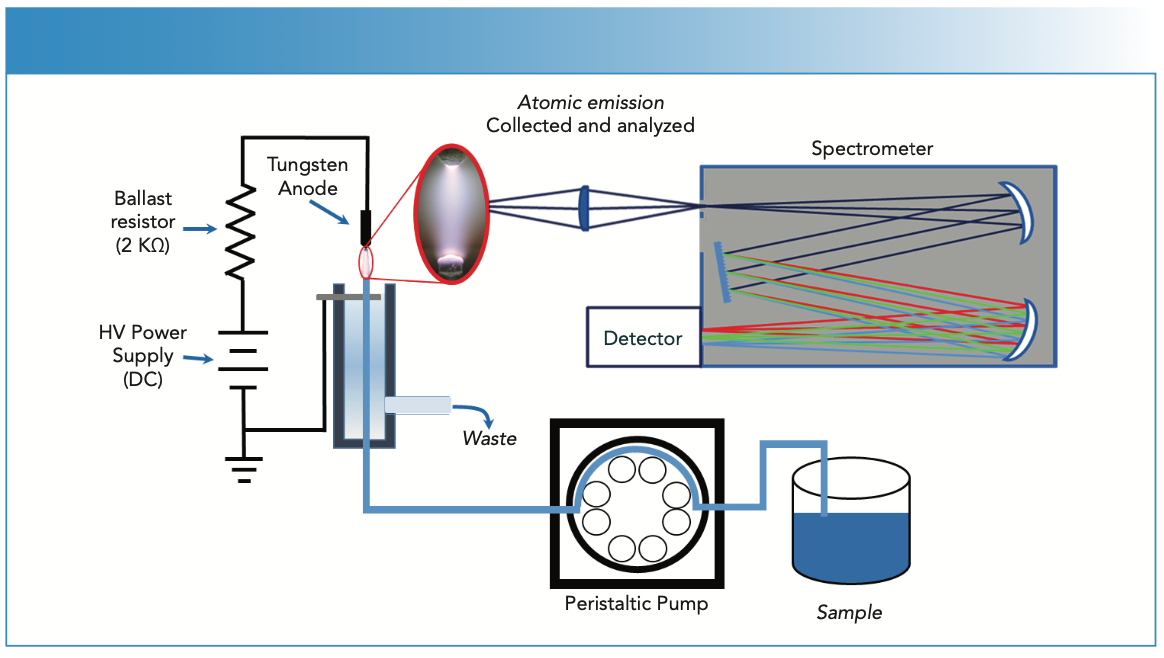
Samples are typically prepared as acidic solutions (1% HNO3). Because the solution forms a part of the electrical circuit, maintaining constant solution conductivity is an important factor in ensuring a reproducible response. A variety of supporting electrolytes, detergents, and chemical additives have been reported as means of controlling solution conditions. Overall, most studies have shown that a low solution pH is the most important factor for optimum AES response in the SCGD, which makes acid digestion a particularly convenient sample pretreatment method. Atomic emission that originates in the SCGD is captured and analyzed in the typical manner, although many studies make use of portable fiber-optic-based spectrometers.
A large number of discharge geometries, solution conditions, and powering schemes have been reported, and several are critically compared in recent reviews (2–5). One popular modification of the SCGD is to simply reverse the applied voltage polarities, forming a solution-anode glow discharge (SAGD). The SAGD retains many of the benefits of the SCGD (low power, simple spectra, and no support gas required), but it has been found to provide enhanced sensitivity and limits of detection to select elements, including silver, bismuth, cadmium, mercury, indium, thallium, and zinc (6). The SAGD is sustained over the same current and voltage range as the SCGD and can use modestly acidified sample; thus, it can be sustained in the same instrumental arrangement as the SCGD.
Analytical Capabilities of the SCGD
A representative SCGD atomic emission spectrum is shown in Figure 2. The background emission from the SCGD plasma differs from argon-based plasmas such as the ICP. Significant broadband molecular background features exist in the range of 250–350 nm because of emission from NO, OH, and N2. The OH (A2Σ+ → X2Π) emission bandhead at 306.4 nm is a particularly significant feature because the SCGD is essentially a water vapor-based discharge. Nitrogen vibronic emission N2 (C3Π → B3Πg) at 337.1 nm and NO (A2Σ+ → X2Π) at 247.9 nm arise from N2 penetrating the interior of the discharge from the surrounding atmosphere. Background atomic emission is also common (oxygen at 777 nm, oxygen at 846 nm, hydrogen at 486 nm, and hydrogen at 656 nm). Figure 2 also includes atomic emission lines of several analyte elements, including gallium, indium, thallium, sodium, lithium, and cesium in a 0.1 M HNO3 matrix. Neutral atomic emission lines are prevalent in the emission spectrum, and emission from ionic lines is weak or nonexistent. Atomic lines used for quantitative analysis are often commonly used in ICP or flame emission spectroscopy, or they are selected based on the spectral regions where the spectral background is low.
FIGURE 2: Example of an SCGD atomic emission spectrum.

Figure 3 summarizes current SCGD-AES limits of detection (LODs) for the elements across the periodic table, where each element is color coded according to approximate LOD. The lowest LODs are found with group I alkali metals, (0.16 μg/L for lithium, 0.04 μg/L for sodium, 0.09 μg/L for potassium, and 1.1 μg/L for cesium), which are values that compare well to those offered by modern ICP-AES instruments. Group II alkali earth metals show slightly higher LODs (3 μg/L for magnesium, 11 μg/L for calcium, and 210 μg/L for strontium). Transition metal LODs vary significantly by element, but often fall between 1–10 μg/L (0.011 μg/L for indium, 0.18 μg/L for silver, 1.1 μg/L for lead, 13 μg/L for cadmium, and 12 μg/L for copper) (2–4). To our knowledge, no data on the analysis of lanthanides and actinides have yet been published, although we have analyzed scandium, yttrium, and lanthanum in our laboratory using the metal oxide vibronic emission and measured LODs of 560 μg/L for yttrium, 2000 μg/L for scandium, and 3700 μg/L for lanthanum. Metalloids (such as tin, antimony, and arsenic) are not analyzed under typical SCGD conditions, but they are often introduced to the plasma as hydrides yielding low LODs (for example, 0.3 μg/L for arsenic, 0.36 μg/L for antimony, 0.2 μg/L for selenium, and 92 μg/L for mercury). Of special note are the poor LODs or complete lack of emission of elements with high oxide bond strength (for example, above 550 kJ/mol), such as boron and tin. This comes as a consequence of the water-vapor nature of the SCGD and SAGD plasma, which encourages formation of oxide and hydroxides.
FIGURE 3: Summary of current SCGD-AES limits of detection (LODs) for elements across the periodic table. Color key to the right of the periodic table graph shows approximate LODs.
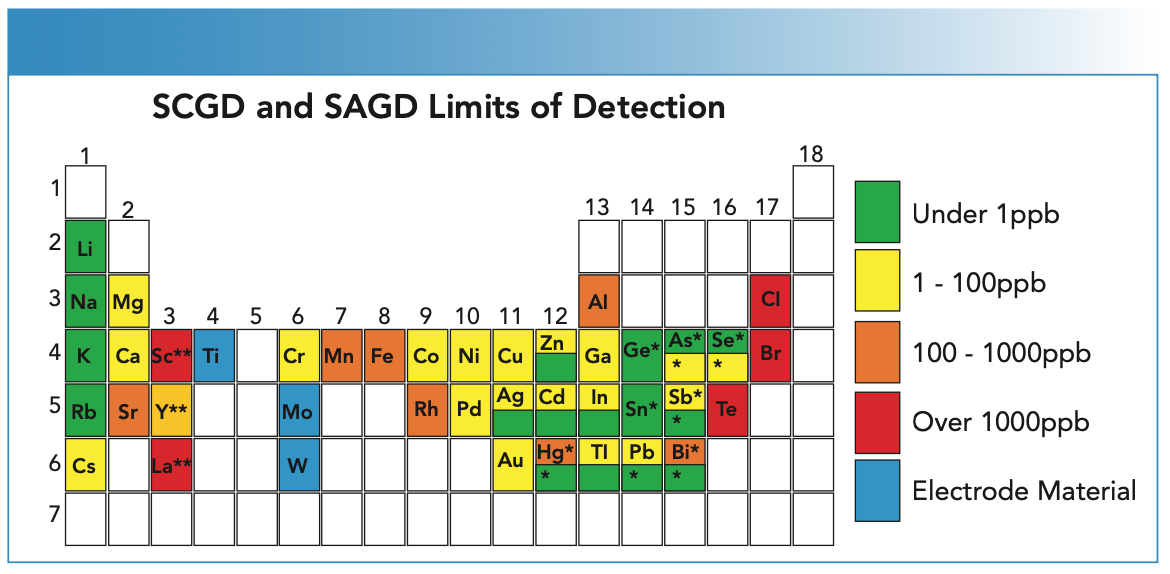
In general, calibration curves of many elements are reported to be linear over 4–5 orders of magnitude, with limits of linearity that often extend beyond 100 mg/L. Signal precision with a relative standard deviation (RSD) less than 1% are routinely reported. Generally, matrix interferences are moderate in severity. Signal suppression caused by high concentrations of easily ionized elements (EIEs), such as sodium, potassium, and lithium present as concomitant species in a sample has been reported. Most literature reports indicate that EIEs present at concentrations above 100 mg/L will measurably suppress emission signal, whereas other interferents show significantly lesser suppression effects even at concentrations of several hundred ppm.
The SCGD and the Plasma–Liquid Interface
Many of the analytical capabilities of the SCGD-AES technique can be traced to its unique structure. The plasma forms directly atop the liquid sample solution surface, and material in the liquid phase is directly removed by the glow discharge to be excited in the plasma. Therefore, both the glow discharge conditions and liquid–plasma interface are important aspects of its performance. Study of the glow discharge plasma has confirmed that the SCGD is essentially a water-vapor atmospheric pressure glow discharge. As shown in Figure 4, the distinct glow discharge spatial structure is easily recognizable in the SCGD. The positive column of the discharge comprises much the SCGD length; however, the cathode glow possesses the greatest electric field. Interestingly, most elements show greatest atomic emission in the regions nearest the liquid surface, as shown in Figure 4. Several researchers have exploited this unique spatial structure to improve LODs by spatially profiling atomic emission or by collecting atomic emission over specific regions of interest (7).
FIGURE 4: (a) Showing the glow discharge spatial structure for the SCGD, and (b) showing the greatest atomic emission at shortest distances from the liquid surface.
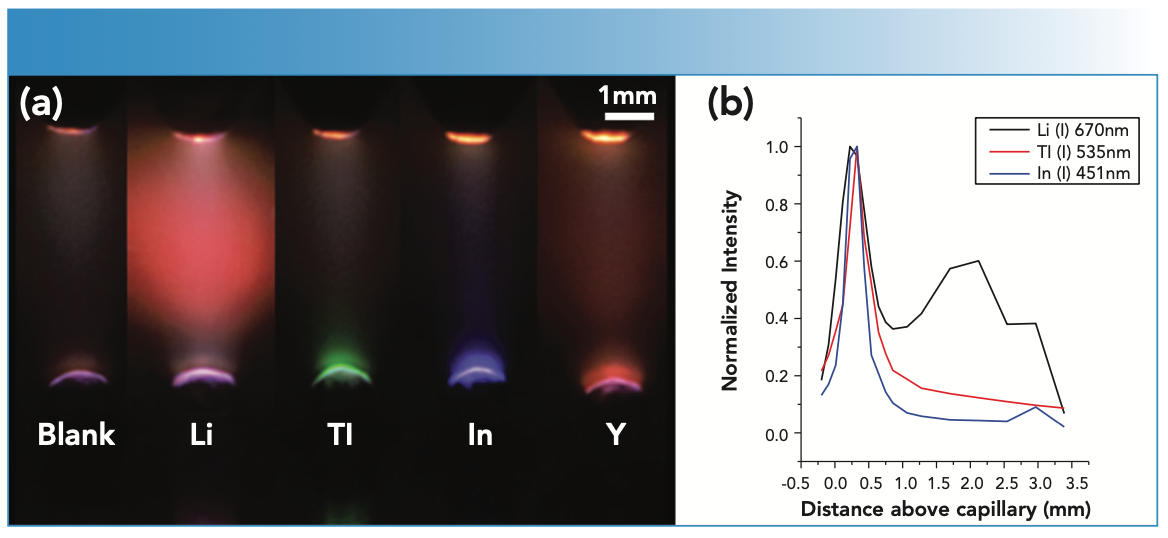
Plasma diagnostic measurements of the SCGD have found the gas temperature of the SCGD plasma to be approximately Trot(OH) = 3500 K, the excitation temperature to be Texc(H) = 5300 K, and the electron number density to be approximately ne = 1014 cm-3 (8). In each case, these diagnostic values are lower than the ICP (ne: ~1015 cm-3, Tg = 7500 K, Texc = 7500 K). Thus, high-energy line excitation and ionization are not prevalent in the SCGD, and matrix interferences related to easily ionizable elements can occur. However, the SCGD does have a gas temperature and ne greater than a conventional flame; thus, the SCGD is not as susceptible to common chemical interferences (that is, SO4 or PO4). Greatest AES sensitivities and lowest LODs in the SCGD have been demonstrated while measuring neutral atomic lines.
There is considerable interest in understanding the plasma–liquid barrier within the SCGD and similar plasmas (7,9). The magnitude of the electric field near the cathodic solution surface in the SCGD has been estimated to be greater than 107 V/m (7). The presence of the plasma in such close proximity to the liquid surface creates a high thermal gradient (106 K/cm) (7). Interestingly, a significant concentration of solvated electrons has also been found to exist at this interphase barrier (10). From the perspective of the AES application, the critical mechanism under study is the transport of material from the liquid to the plasma, and a number of mechanisms have been hypothesized. Recently, studies have shown that the plasma is not homogeneous, but rather composed of a number of individual tendrils, as shown in Figure 5a. These tendrils originate in the positive column and branch out toward the cathode surface. Each tendril forms a unique cathode spot on the liquid surface from which atomic emission is often collocated. The tendrils move rapidly over the solution surface, releasing droplets from the surface into the plasma. The electric field near the liquid surface of the SCGD is also sufficient to support electrospray jet formation, and indeed, several studies have reported observation of Taylor cones at the liquid surface (3,7,9). As shown in Figure 5b, imaging using low-angle laser light scattering reveals that the surface of the solution is highly perturbed, and the presence of a large number of droplets ejected from the liquid into the plasma (11). These observations suggest that material could be moved into the plasma by an electrospray mechanism.
FIGURE 5: (a) The SCGD without capillary. Shutter speed was 1/4000 s. (b) Photo of the surface of the SCGD with a capillary. Viewed at 15 degrees from an incident 658-nm laser.
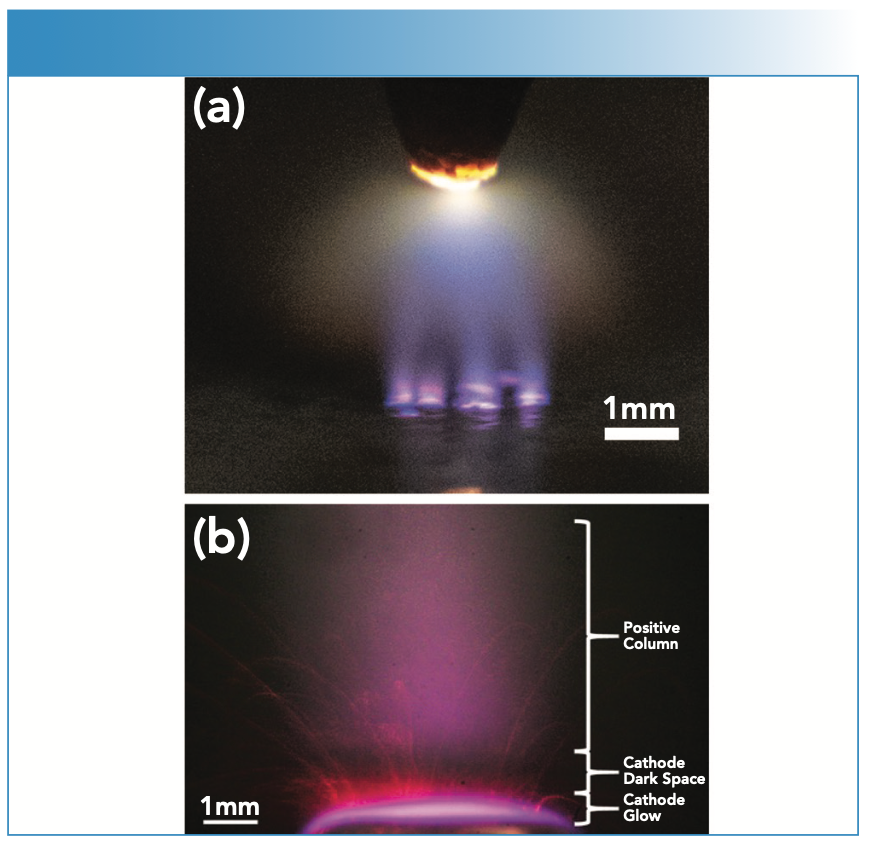
Applications
The SCGD excels at the determination of trace and ultratrace elements in sample solutions that are of a conserved type and that are readily adapted to the conductivity requirements of the sample preparation. Trace-level analysis applications, such as ground water analysis, bottled water analysis, and waste effluent streams, by direct analysis have been reported. More complex samples have also been quantitatively analyzed for trace-level elemental content with only minor sample pretreatment, including vaccines, honey, wine, spruce needles, trace metal in silica colloids, nanoparticles, and fruit juice samples (3). Like in conventional ICP-OES, more complex sample matrices are usually acid digested before analysis via SCGD. For example, Mo and coworkers digested human hair and stream sediment for lead quantitation, achieving a LOD of 0.91 μg/L. A more comprehensive list of applications is available in recent review articles (2–5).
Because the SCGD analyzes a continuous flowing liquid stream with a surface that is constantly replenished, coupling the SCGD to chromatographic separations is simple. Several liquid chromatography (LC) separations (for example, speciation of chromium) have been reported. Schwartz and others reported development of a novel ion chromatography approach known as replacement ion chromatography. Here, the exceptional sensitivity of the SCGD to lithium emission is exploited to indirectly determine anion species, including F- and Cl-, with LODs below 1 ppm (12). The rapid response of the SCGD makes it particularly attractive for flow-in- jection analysis (FIA) strategies. Shekhar and coworkers reported the development of an FIA strategy for mercury determinations in ground water samples, achieving a 1 ng absolute mass detection limit. Schwartz and others used FIA-SCGD and a simple interference filter wheel for the analysis of several elements, including lithium, sodium, potassium, and rubidium, demonstrating 1–10 ng/mL LODs. The use of FIA is particularly effective when coupled to preconcentration schemes. For example, analysis of chromium, mercury, and lead was performed using an in-line column with treated mesoporous silica placed before analysis using SCGD-AES. Using this preconcentration SCGD-AES scheme, LODs of 0.75 μg/L, 0.91 μg/L, and 0.75 μg/L for cadmium, lead, and mercury, respectively, were achieved (3).
Hydride generation (HG) and chemical vapor generation (CVG) sample introduction approaches are particularly effective when used with the SCGD. Elements such as arsenic, antimony, selenium, germanium, and tin are not amenable to direct atomic analysis via SCGD or SAGD because of either high excitation energies or high oxide bond strengths. These elements are often analyzed by hydride generation prior to SCGD-AES (that is, AsH3 and SnH4), which separates the analyte from the matrix and acts as sample pretreatment. Using hydride generation also permits complex sample matrices to be analyzed; for example, using a hydride-generation modified SCGD, Greda and coworkers recently demonstrated a LOD of 0.066 μg/L for mercury in digested moss samples (13). Peng and others studied gas streams of argon and helium combined with HG-SAGD for the determination of lead, reaching an LOD of 0.061 μg/L (14). Guo and coworkers determined arsenic with an LOD of 0.3 μg/L, demonstrating arsenic speciation (As(III) and As(V)) (15). An especially creative way to create volatile antimony species was reported by Zhu and coworkers. Here, a small amount of hydrogen gas added to a helium-supported SAGD allowed single-step hydride formation and analysis of antimony solutions, with an LOD of 0.85 μg/L (16).
Alternative Geometries and Other Research Directions
The SCGD is a robust and flexible platform for AES that many research groups are adapting for a variety of applications. Various alternative methods of powering the SCGD plasma, such as alternating current (AC) waveforms, or microsecond pulsed discharges for high instantaneous power have been investigated. A variety of different cathode structures and shapes have also been reported. Our laboratory has recently developed a horizontal, slit- shaped discharge cathode by forming the plasma between a wedge-shaped titanium anode and a hollow rectangular capillary. A schematic of this plasma is shown in Figure 6 along with close-up photos of the plasma while sampling indium and thallium, and it was shown that this geometry is able to improve sensitivity by as much as 30 times compared to the conventional SCGD system. A battery-operated form of the SCGD experiment developed by Peng and coworkers achieved LODs of 7 μg/L, 92 μg/L, 23 μg/L, and 10 μg/L for elements cadmium, mercury, lead, and zinc, respectively (17). Continuous battery-powered analysis could be performed for approximately 4 h.
FIGURE 6: Horizontal SCGD: (a) Experimental schematic. Pictures: 0.3 x 3 mm capillary, 3-mm discharge gap, 3.0 mL/min 0.1 M HNO3. (b) 80 mA, 10 mg/L indium, (c) 80 mA, 10 mg/L thallium.
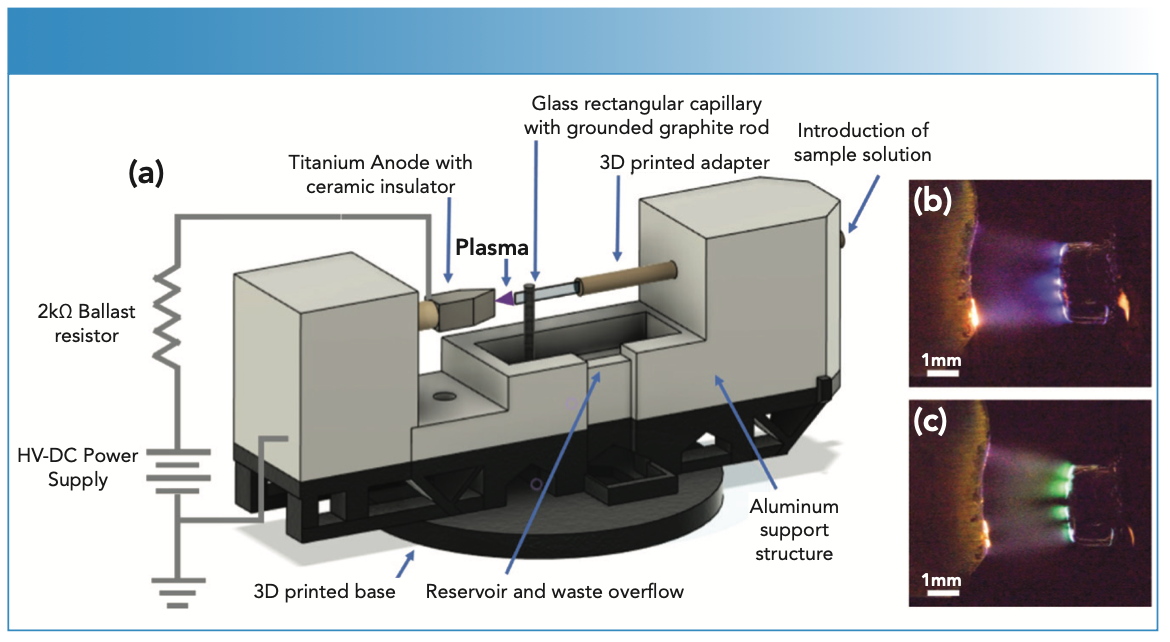
In several instances, the SCGD has been used as a means to generate volatile species for subsequent analysis using a different AES technique, such as ICP-AES. Solutions containing the analytes of interest are introduced to the SCGD, and volatile species passed through a gas–liquid separator before introduction to the ICP. This method showed an increase in sensitivities from 10–30 times compared to conventional nebulization, achieving LODs of 0.3 μg/L for iodine, 0.51 μg/L for osmium, and 0.22 μg/L for mercury (18–20).
Liquid–plasma discharges have also found utility an ionization sources for atomic and molecular mass spectrometry (MS). Shelley and coworkers have used the SCGD as a molecular ionization source, demonstrating that elemental species (for example, uranium and uranium oxide), small molecules, and proteins up to 2200 Da can be analyzed as intact protonated ions (21). LODs from 0.4 to 1 ppb for elemental species, including uranium as UO2 were reported, while the LOD for the chemical warfare simulant triethyl phosphate (TEP) was determined to be approximately 0.2 ppb. Interestingly, the fragmentation pattern of the protein could be encouraged by changing SCGD conditions. Marcus and coworkers have demonstrated a combined atomic and molecular (CAM) ionization source based on a liquid–plasma of a similar type that can be retrofit directly to commercial molecular mass spectrometers. They have demonstrated isotope ratio measurements with excellent accuracy and precision, and have recently demonstrated analysis of 87Sr and 87Rb with sufficient resolution and accuracy to be used in geological dating applications (22).
The unique environment of the plasma–liquid interface has also been exploited beyond the scope of analytical spectroscopy. Liquid–plasma discharges have been applied applications as diverse as the synthesis of nanoparticles, bacterial inactivation, wound healing, and water treatment. The wide breadth of areas of investigation speak to the versatility and the wide utility of these plasma–liquid structures (3–5,23).
Conclusions and Future Directions
The SCGD is a unique AES source concept with analytical utility that is largely untapped. The SCGD-AES ease of use, compact design, good analytical performance, and wide elemental applicability can be applied with little operational cost. Research efforts intended to address the current limitations of the SCGD-AES approach are ongoing. Improving detection limits and addressing analysis of elements with poor analysis performance (for example, elements that form strong oxide bonds) is being addressed by studying methods to increase the power density and temperature of the SCGD plasma. New strategies for hydride generation have also been explored, and novel preconcentration and segmental flow sample treatment schemes created to explore new and more complex applications. As important, research aimed at understanding the fundamental aspects of plasma–liquid boundary continues. As mechanistic understanding of this novel interface improves, new understanding will certainly be applied to improve the SCGD-AES application.
Acknowledgments
This work was supported by the State University of New York at Buffalo. The authors thank Indiana University and Professor Gary Hieftje for the donation and loan of some of the equipment used in this work. The authors also thank and acknowledge the ICP Information Newsletter and Professor Ramon Barnes for support.
References
(1) Cserfalvi, T.; Mezei, P.; Apai, P. J. Emission Studies on a Glow Discharge in Atmospheric Pressure Air Using Water as a Cathode. Phys. D: Appl. Phys. 1993, 26, 2184. DOI: 10.1088/0022-3727/26/12/015
(2) Webb, R.; Hieftje, G. M. Spectrochemical Analysis by Using Discharge Devices with Solution Electrodes. Anal. Chem. 2009, 81, 862–867. DOI: 10.1021/ac801561t.
(3) Pohl, P.; Jamroz, P.; Greda, K.; et al. Five Years of Innovations in Development of Glow Discharges Generated in Contact with Liquids For Spectrochemical Elemental Analysis by Optical Emission Spectrometry. Anal. Chim. Acta 2021, 1169, 338339. DOI: 10.1016/j.aca.2021.338399
(4) Pohl, P.; Jamroz, P.; Swiderski, K.; et al. Critical Evaluation of Recent Achievements in Low Power Glow Discharge Generated at Atmospheric Pressure Between a Flowing Liquid Cathode and a Metallic Anode for Element Analysis by Optical Emission Spectrometry. TRAC – Trend Anal Chem. 2017, 88, 119–133. DOI: 10.1016/j.trac.2017.01.002
(5) Peng, X.; Wang, Z. Systematic Evaluation of Advance in Application and Discharge Mechanism of Solution Electrode Glow Discharge. Chin. Chem. Lett. 2022, 33, 61–70. DOI: 10.1016/j.cclet.2021.06.017
(6) Greda, K.; Swiderski, K.; Jamroz, P. ; et al. Flowing Liquid Anode Atmospheric Pressure Glow Discharge as an Excitation Source for Optical Emission Spectrometry with the Improved Detectability of Ag, Cd, Hg, Pb, Tl, and Zn. Anal. Chem. 2016, 17, 8812–8820. DOI: 10.1021/acs.analchem.6b02250
(7) Schwartz, A.; Ray, S.; Elish, E.; et al. Visual Observations of an Atmospheric-Pressure Solution-Cathode Glow Discharge. Talanta 2012, 102, 26–33. DOI: 10.1016/j.talanta.2012.07.096
(8) Mezei, P.; Cserfalvi, T. A Critical Review of Published Data on the Gas Temperature and the Electron Density in the Electrolyte Cathode Atmospheric Glow Discharges. Sensors 2012, 12, 6576–6586. DOI: 10.3390/s120506576
(9) Moon, D.; Webb, M. J. Imaging Studies of Emission and Laser Scattering from a Solution-Cathode Glow Discharge, Anal. At. Spectrom. 2020, 35, 1859–1867. DOI: 10.1039/D0JA00134A
(10) Elg, D.; Delgado, H.; Martin, D.; et al. Recent Advances in Understanding the Role of Solvated Electrons at the Plasma-Liquid Interface of Solution-based Gas Discharges. Spectrochim. Acta, Part B 2021, 186, 106307. DOI: 10.1016/j.sab.2021.106307
(11) Orejas, J.; Hazel, N.; Ray, S. The Solution-Cathode Glow Discharge in Slow Motion: Characterization of Glow Discharge Filament Structure and Droplet Ejection Using a Rectangular Capillary. Spectrochim. Acta, Part B 2021, 181, 106209. DOI: 10.1016/j.sab.2021.106209
(12) Schwartz, A.; Wang, Z.; Ray, S. Universal Anion Detection by Replacement-Ion Chromatography with an Atmospheric-Pressure Solution-Cathode Glow Discharge Photometric Detector. Anal Chem. 2013, 85, 129–137 (2013). DOI: 10.1021/ac3022554
(13) Greda, K.; Kurchach, K.; Ochromowicz, K.; et al. Determination of Mercury in Mosses by Novel Cold Vapor Generation Atmospheric Pressure Glow Microdischarge Optical Emission Spectrometry after Multivariate Optimization, J. Anal. At. Spectrom. 2015, 30, 1743. DOI: 10.1039/c5ja00170f
(14) Peng, X.; Zhao, M.; Yuan, M.; et al. Solution Anode Glow Discharge Optical Emission Spectrometry: Volatile Hydride Introduction from the Gas Jet Nozzle Cathode For Ultrasensitive Determination of Lead. Talanta 2021, 225, 121995. DOI: 10.1016/j.talanta.2020.121995
(15) Guo, X.; Peng, X.; Li, Q.; et al. Ultra-sensitive Determination of Inorganic Arsenic Valence by Solution Cathode Glow Discharge-Atomic Emission Spectrometry Coupled with Hydride Generation. J. Anal. At. Spectrom. 2017, 32, 2416–2422. DOI: 10.1039/c7ja00228a
(16) Yang, C.; Cheng, G.; Cheng, S.; et al. Direct and Sensitive Determination of Antimony in Water by Hydrogen-Doped Solution Anode Glow Discharge-Optical Emission Spectrometry Without Hydride Generation. Anal. Chem. 2021, 93, 16393–16400. DOI: 10.1021/acs.analchem.1c02940
(17) Peng, X.; Guo, X.; Ge, F.; et al. Battery-operated Portable High-throughput Solution Cathode Glow Discharge Optical Emission Spectrometry for Environmental Metal Detection. J. Anal. At. Spectrom. 2019, 34, 394–400. DOI: 10.1039/C8JA00369F
(18) Zhu, Z.; He, Q.; Shuai, Q.; et al. Solution Cathode Glow Discharge Induced Vapor Generation of Iodine for Determination by Inductively Coupled Plasma Optical Emission Spectrometry. J. Anal. At. Spectrom. 2010, 25, 1390–1394. DOI: 10.1039/b927298d
(19) Zhu, Z.; Huang, C.; He, Q.; et al. On line Vapor Generation of Osmium Based on Solution Cathode Glow Discharge for the Determination by ICP-OES. Talanta. 2013, 106, 133–136. DOI: 10.1016/j.talanta.2012.12.010
(20) Cai, Z.; Zou, H.; Chen, Y.; et al. Ultrasensitive Determination of Mercury by ICP-OES Coupled with a Vapor Generation Approach Based on Solution Cathode Glow Discharge. Chin. Chem. Lett. 2022, 33 (5), 2692–2696. DOI: 10.1016/j.cclet.2021.09.107
(21) Schwartz, A.; Williams, K.; Hieftje, G. ; et al. Atmospheric-Pressure Solution-Cathode Glow Discharge: A Versatile Ion Source for Atomic and Molecular Mass Spectrometry. J. Anal. Chim. Acta. 2017, 950, 119–128. DOI: 10.1016/j.aca.2016.10.045.
(22) Hoegg, E.; Godin, S.; Szpunar, J.; et al. Resolving Severe Elemental Isobaric Interferences with a Combined Atomic and Molecular Ionization Source–Orbitrap Mass Spectrometry Approach: The 87Sr and 87Rb Geochronology Pair. Anal. Chem. 2021, 93, 11506–11514. DOI: 10.1021/acs.analchem.1c01795
(23) Bruggeman, P.; Bogaerts, A.; Pouvesle, J.; et al. Plasma–Liquid Interactions. J. Appl. Phys. 2021, 130, 200401. DOI: 10.1063/5.0078076
Nicholas Hazel and Steven Ray are with the Department of Chemistry at the State University of New York at Buffalo, in Buffalo, New York. Jaime Orejas is with the Department of Physics at the University of Oviedo, in Oviedo, Spain. The authors were awarded the 2021 Edward Steers Memorial Award in recognition of their work in glow discharge spectrometry. Direct correspondence to: sjray2@buffalo.edu ●
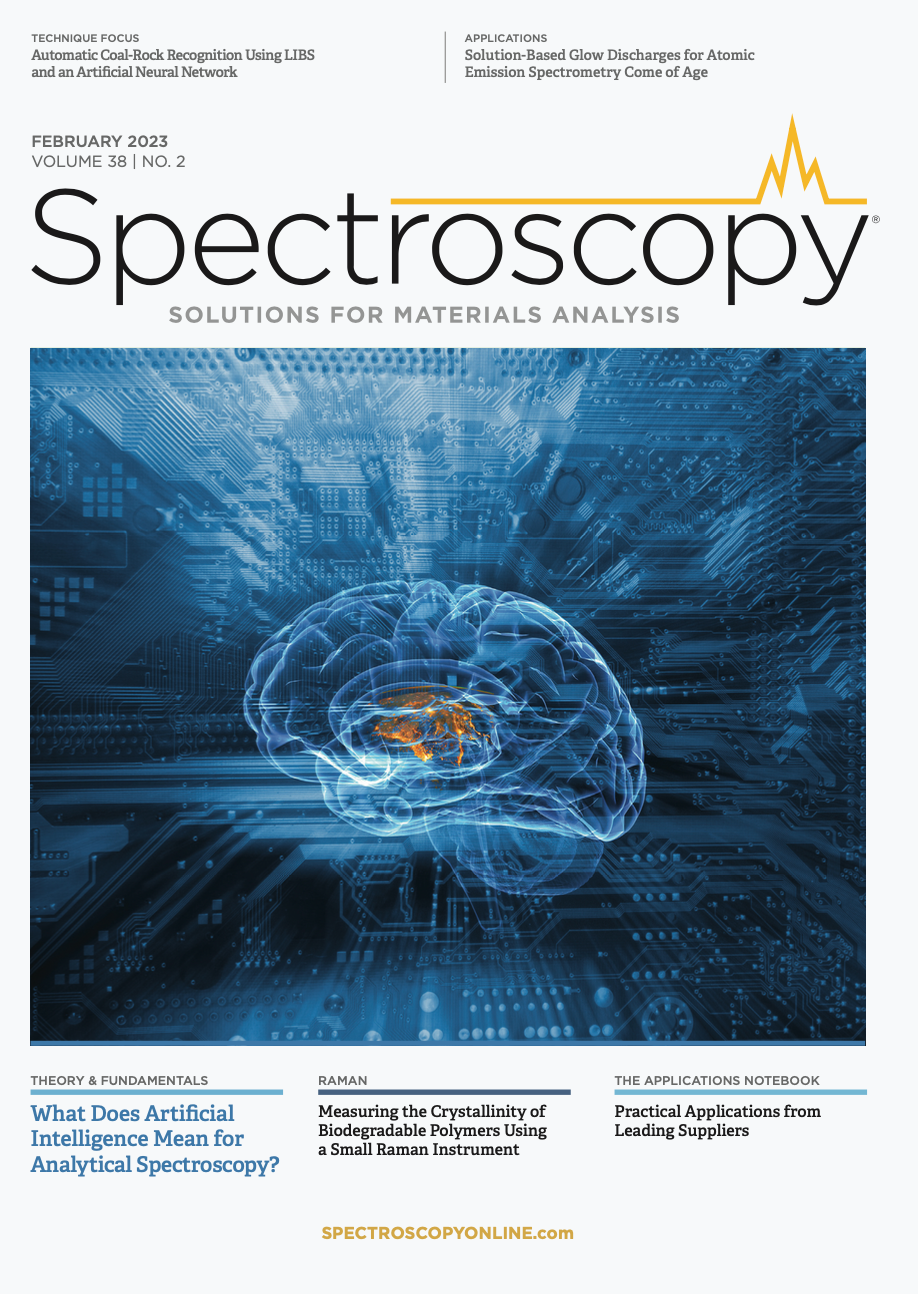
LIBS Illuminates the Hidden Health Risks of Indoor Welding and Soldering
April 23rd 2025A new dual-spectroscopy approach reveals real-time pollution threats in indoor workspaces. Chinese researchers have pioneered the use of laser-induced breakdown spectroscopy (LIBS) and aerosol mass spectrometry to uncover and monitor harmful heavy metal and dust emissions from soldering and welding in real-time. These complementary tools offer a fast, accurate means to evaluate air quality threats in industrial and indoor environments—where people spend most of their time.
Atomic Perspectives: Highlights from Recent Columns
March 3rd 2025“Atomic Perspectives,” provides tutorials and updates on new analytical atomic spectroscopy techniques in a broad range of applications, including environmental analysis, food and beverage analysis, and space exploration, to name a few. Here, we present a compilation of some of the most popular columns.